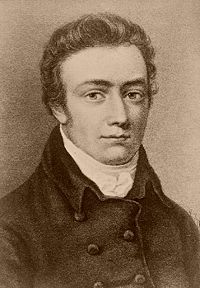(Added intro and tweaked format.) |
No edit summary |
||
| (One intermediate revision by the same user not shown) | |||
| Line 1: | Line 1: | ||
{{:Poetry/Tabs}} | {{:Poetry/Tabs}} | ||
{{see also|Romanticism: Revolt of the Spirit}} | {{see also|Romanticism: Revolt of the Spirit}} | ||
{{dc|R}}{{start|omanticism refers to the poetry of the Romantic era}}, which emerged in the late 18th century and lasted until the mid-19th century. | |||
{{Collapse top|title=General Characteristics|bg=#F0F2F5|left=yes}} | {{Collapse top|title=General Characteristics|bg=#F0F2F5|left=yes}} | ||
| Line 55: | Line 55: | ||
| colspan="3" | {{Big|Emily Dickinson}} | | colspan="3" | {{Big|Emily Dickinson}} | ||
|- style="vertical-align: top;" | |- style="vertical-align: top;" | ||
| colspan="3" | {{bulleted list|“[[Above Oblivion’s Tide]]”}} | | colspan="3" | {{bulleted list|“[[Above Oblivion’s Tide]]”|“[[February 22, 2023|Because I Could Not Stop for Death]]”}} | ||
|- | |- | ||
| colspan="3" | {{Line}} | | colspan="3" | {{Line}} | ||
Latest revision as of 08:56, 23 February 2023
Romanticism refers to the poetry of the Romantic era, which emerged in the late 18th century and lasted until the mid-19th century.
General Characteristics
|
|---|
|
Some general characteristics of Romantic poetry include:
These characteristics are not exhaustive, and there is considerable variety within Romantic poetry. However, they provide a general sense of the key features of the genre. |
| William Blake | ||
| From Songs of Innocence: | From Songs of Experience: | |
| Elizabeth Barrett Browning | ||
| George Gordon, Lord Byron | ||
| Mary Elizabeth Coleridge | ||
| Samuel Taylor Coleridge | ||
| Emily Dickinson | ||
| John Keats | ||
| Edgar Allan Poe | ||
| Percy Bysshe Shelley | ||
| William Wordsworth | ||






